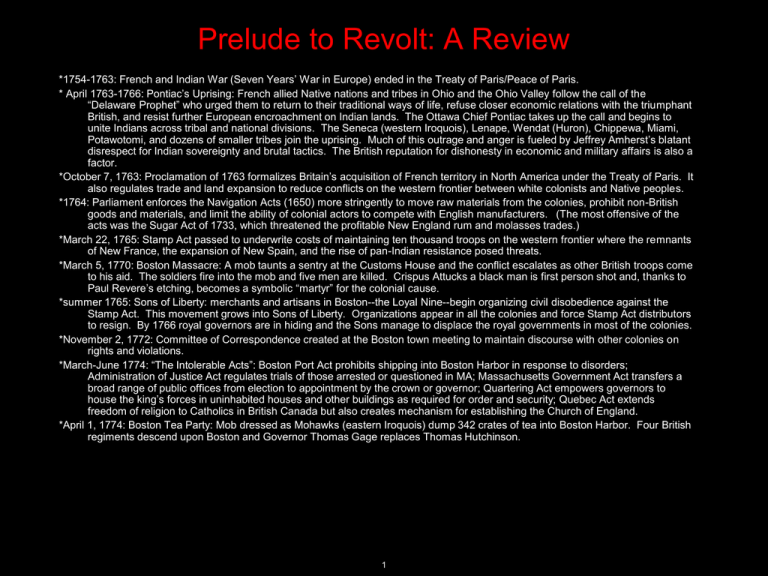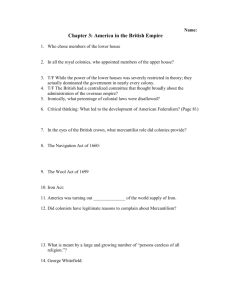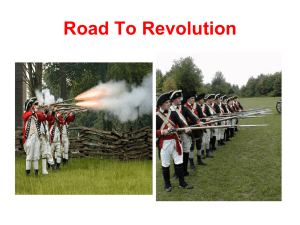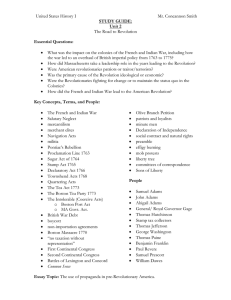Prelude to Revolt: A Review
advertisement

Prelude to Revolt: A Review *1754-1763: French and Indian War (Seven Years’ War in Europe) ended in the Treaty of Paris/Peace of Paris. * April 1763-1766: Pontiac’s Uprising: French allied Native nations and tribes in Ohio and the Ohio Valley follow the call of the “Delaware Prophet” who urged them to return to their traditional ways of life, refuse closer economic relations with the triumphant British, and resist further European encroachment on Indian lands. The Ottawa Chief Pontiac takes up the call and begins to unite Indians across tribal and national divisions. The Seneca (western Iroquois), Lenape, Wendat (Huron), Chippewa, Miami, Potawotomi, and dozens of smaller tribes join the uprising. Much of this outrage and anger is fueled by Jeffrey Amherst’s blatant disrespect for Indian sovereignty and brutal tactics. The British reputation for dishonesty in economic and military affairs is also a factor. *October 7, 1763: Proclamation of 1763 formalizes Britain’s acquisition of French territory in North America under the Treaty of Paris. It also regulates trade and land expansion to reduce conflicts on the western frontier between white colonists and Native peoples. *1764: Parliament enforces the Navigation Acts (1650) more stringently to move raw materials from the colonies, prohibit non-British goods and materials, and limit the ability of colonial actors to compete with English manufacturers. (The most offensive of the acts was the Sugar Act of 1733, which threatened the profitable New England rum and molasses trades.) *March 22, 1765: Stamp Act passed to underwrite costs of maintaining ten thousand troops on the western frontier where the remnants of New France, the expansion of New Spain, and the rise of pan-Indian resistance posed threats. *March 5, 1770: Boston Massacre: A mob taunts a sentry at the Customs House and the conflict escalates as other British troops come to his aid. The soldiers fire into the mob and five men are killed. Crispus Attucks a black man is first person shot and, thanks to Paul Revere’s etching, becomes a symbolic “martyr” for the colonial cause. *summer 1765: Sons of Liberty: merchants and artisans in Boston--the Loyal Nine--begin organizing civil disobedience against the Stamp Act. This movement grows into Sons of Liberty. Organizations appear in all the colonies and force Stamp Act distributors to resign. By 1766 royal governors are in hiding and the Sons manage to displace the royal governments in most of the colonies. *November 2, 1772: Committee of Correspondence created at the Boston town meeting to maintain discourse with other colonies on rights and violations. *March-June 1774: “The Intolerable Acts”: Boston Port Act prohibits shipping into Boston Harbor in response to disorders; Administration of Justice Act regulates trials of those arrested or questioned in MA; Massachusetts Government Act transfers a broad range of public offices from election to appointment by the crown or governor; Quartering Act empowers governors to house the king’s forces in uninhabited houses and other buildings as required for order and security; Quebec Act extends freedom of religion to Catholics in British Canada but also creates mechanism for establishing the Church of England. *April 1, 1774: Boston Tea Party: Mob dressed as Mohawks (eastern Iroquois) dump 342 crates of tea into Boston Harbor. Four British regiments descend upon Boston and Governor Thomas Gage replaces Thomas Hutchinson. 1 Britain’s Fatal Triumph The Aftermath of the French and Indian War (1754-1763) 2 The European Great Migration Map of European migration removed due to copyright restrictions. See: Introduction to Colonization This image is public domain. How Germans, Scots, Swedes, Hollanders (and Quakers and Presbyterians and Mennonites and Anglicans and Congregationalists and Hugenots and Lutherans) etc. became white. 3 The Immigrant Trade This image is public domain. The Pennsylvania Germans (Dutch) 4 Peter Jefferson’s Son . . . and his friend Meriwether Lewis 5 George Washington’s Childhood George Washington at 16 Thomas Lord Fairfax VI Surveyor of Indian Lands 6 Queen Aliquippa, 1754 George Washington and Christopher Gist pay homage Surveying lands in western Pennsylvania 7 Colonel Washington The Virginia Militia Officer Surveys Ohio (while on duty during the French and Indian War) 8 West of Appalachia Mr. Floyd has sent you a Description of 3000 Acres of Land he surveyed last Summer and which has not been appropriated. Should this suit, let me now by a Line & I will make out a Certificate & send it to any Place you direct. As I imagine you will receive this before you set off for the Congress, you can send an Answer to the Care of Alex[ande]r Craig in W[illia]msburg at the meeting of the Merchants from whence I can readily get it. But if this Land will not answer your Purpose I can readily have a Tract Surveyed as Floyd sets off tomorrow for the Ohio & I can when I receive your Letter have an Opp[ortunit]y of writing him. The Warrant should be lodged with me, if it is sent to Mr. Craig I can get it safe. --Col. William Preston to General George Washington, April 9, 1775 (Washington’s family owns significant land claims in Pennsylvania and Ohio. Many Virginians have invested heavily in these western lands.) 9 The Advent of Biological Warfare Lord Jeffrey Amherst Commander of the British forces in North America Col. Henry Bouquet and the Ottawa Chiefs At virtually the same moment that Franklin and other intellectual and political leaders are condemning the massacres in Conestoga and Lancaster, PA, Amherst is designing biological warfare against the western Indians and he’s being celebrated as a hero. 10 The Conestoga Massacres The Extermination of the Susquehannocks, 1763 The “Paxton Boys” march on Conestoga (Paxtung Presbyterian Church in PA) 11 Eastern Elite v. Backcountry Settlers The Paxton Boys March toward Philadelphia 12 Savages and Slaves . . . the number of purely white People in the World is proportionably very small. . . . why Should we in the Sight of Superior Beings, Darken its People? why increase the sons of Africa, by Planting them in America, where we have so fair an Opportunity, by excluding all Blacks and Tawneys, of increasing the lovely White and Red? But perhaps I am partial to the Complexion of my Country, for such kind of Partiality is natural to Mankind. --Benjamin Franklin, 1751 The Racial Destiny of Colonial America 13 MIT OpenCourseWare http://ocw.mit.edu 21H.001 How to Stage a Revolution Fall 2013 For information about citing these materials or our Terms of Use, visit: http://ocw.mit.edu/terms.





